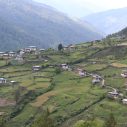
Search
“Nowadays we do not create public policies for housing that do not take the local environment into account”

Chile launched an official Multidimensional Poverty Index in 2015. A year and a half later, this index was modified to add local environment to the Housing dimension and a fifth innovative dimension: networks and social cohesion. Dimensions Magazine spoke with Heidi Berner, Undersecretary of Social Evaluation of the Chilean Ministry of Social Development, about these additions and the way the government is using the MPI in the design and implementation of public policies.
Among the countries that have carried out a process of creating an official poverty measurement, Chile is the only one in which the measurement has been reformulated shortly after its launching. Can you tell us more about this situation?
The multidimensional poverty measurement had as a key input a report made by the Commission for the Measurement of Poverty. This commission, appointed by former President Piñera [2010-2014], was very broad because it incorporated academics from different fields, politicians and members of the civil society working on poverty issues. This report suggested updating the existing income poverty measurement to the current consumption patterns, and to incorporate a multidimensional poverty measurement.
The Commission recommended working with traditional multidimensional poverty dimensions: health, education, employment and social security, and housing. Additionally, it suggested incorporating the dimension of local environment and social networks. When we came into government [current government of President Michelle Bachelet, 2014-2018], we took this report as a starting point and began working with other additional actors: ECLAC, OPHI and a Casen panel [group of independent experts in charge of the revision of the main household survey called “Casen”] which were at that moment supporting the process of conducting the survey. With all these analyses, we reached the conclusion that the questions included in the 2013 Casen survey (the one we use for poverty data) regarding local environment and social networks were not solid enough to be included at that time in the measurement.
It is important to note that the desire to include local environment and networks in the measurement of multidimensional poverty was present from the beginning, but they were not being well captured in the household survey. For that reason, when we launched the measurement methodology in December 2015, with the presence of Sabina Alkire and James Foster, we made a commitment to include local environment and social networks in the next measurement drawn from the 2015 Casen survey. For this, we convened a Committee of Experts to guarantee the correct incorporation of the right questions in the 2015 Casen survey, and later to advise in the measurement of multidimensional poverty based on this database. While it is true that it seems we changed the original measure rather quickly, it was always established that this was an important issue, but we just did not have the necessary data to include it.
There is a perception that this type of changes can generate certain conflicts or be very chaotic. Did you find any resistance to carry forward these changes?
This process was different because there was a clear demand from civil society, academia, and those in charge of public policies. Nowadays, for example, we do not create public policies for housing that do not consider the local environment where those households are located, including access to public transport, health facilities, and educational establishments. From that perspective, there was no resistance. Actually, politically speaking, it would have been much more delicate for us not to incorporate this change, given that it was already in the agenda and that it is consistent with the public policies we are promoting as a Government.
How does Chile use the Multidimensional Poverty Index (MPI) for its public policies?
It is used in different ways. In the case of housing, for example, the MPI is completely aligned with the work done by the Ministry of Housing. First, the Ministry of Housing has policies that seek to reduce the quantitative housing deficit, that is, people that require a house because, among other things, they live with a significant level of overcrowding. For the Ministry of Housing, overcrowding is an important factor when selecting recipients for housing benefits. Therefore, overcrowding is included in the multidimensional poverty index.
Second, the Ministry of Housing implements policies that seek to reduce the qualitative deficit, that is, to improve housing that is in poor condition, through programmes that help people repair their houses. These issues are also reflected in the MPI. When new residential complexes are constructed, the Ministry of Housing provides the parameters that must be followed when building a neighbourhood. These parameters include the distance from the education and health facilities and access to public transportation, variables that are included in the local environment indicator of the multidimensional poverty measure.
“What we did was to create a Social Household Register consistent with multidimensional poverty.”
Regarding education, we use the MPI as a guide to identify, through the Social Household Register, deprived households, especially those with children that do not attend school. What we did was to create a Social Household Register consistent with multidimensional poverty. If you generate registers you can know exactly the location of families and children that have the problems you are capturing through the multidimensional poverty index. This could not have been done if the registration system was based only on income, where you would hardly know which households are the ones that really suffer the multidimensional poverty problems. That is what we did with the Social Household Register. These two instruments have been created from a common logic.
To give you an example, in the Metropolitan Region, we have school enrolment administrative data. Currently, we are looking for those children who do not attend school, amounting to 2.3% [of all children] (according to the MPI) – which may not seem like much, but we are talking about more than 25,000 children who do not attend school in Santiago. This is a relevant number for us, and therefore we are designing policies that allow us, based on the other instrument that is the Social Household Register, to find those children identified through the MPI and to effectively generate support programmes that enable them to reintegrate into the school system.
Including local environment and networks in the modification of the index is highly striking and innovative. Can you tell us what this consists of?
The first change we made in the index was in the “housing” dimension, where we incorporated the local environment; it is now called “housing and local environment”. This is because the housing indicators that originally existed in our multidimensional poverty index were strictly related to the material aspects of the house as well as overcrowding. But the local environment indicators were conceived with a more holistic perspective, with reference to the local area where the house is located.
Currently in Chile, when we think about housing, in addition to solving problems of access to safe drinking water, sewage, state of the dwelling, and overcrowding, we now think about what happens to a member of the household if he or she has to commute more than an hour to get to a health facility or it takes more than an hour for the children to get to school. That is why we consider it relevant to include an indicator that shows a house’s relationship to its local environment. We conceive of this environment as relating to access to basic services beyond safe drinking water and sewage, such as education, health, and access to public transportation.
Regarding networks and social cohesion, we thought it had to be an altogether different dimension from the other four. As a country, we have learned that we must shift from a representative democracy to a participatory democracy. Following that logic, it is important to analyse if households have access to support networks when facing a problem. We measure this support through different questions such as “Do you know anyone from outside your household who can support you if…” and we mention a set of problems. The next question is “Do you participate in a community organisation, in a sports club?” The third asks if they participate in a trade union, if they are working, et cetera. Then, if they answer three times ‘no’, we are talking about a household with few connections to the system it inhabits. It is a social cohesion deficit that, it seems to us, is very relevant to comprehensive poverty and inequality reduction policies.
Another issue we found very important when measuring networks and social cohesion is discrimination. In Chile there have been several studies showing that one of the subjects frequently raised by people living in poverty is having felt discrimination. We also wanted to measure this discrimination but not just in terms of income – discrimination can be because I am a woman, an older person, a child, an immigrant, or because of my sexual orientation, among others.
Another emerging issue in Chile’s public policies is the level of violence that we come into contact with and, in particular, establishing if people live in places where they systematically face shootings and drug trafficking. Our public security policy is tackling those issues and, therefore, this dimension gives them an indicator that will systematically measure such occurrences.
*Translated from Spanish into English by Helena Martinez, UN Volunteer. Revised by Ann Barham.
















